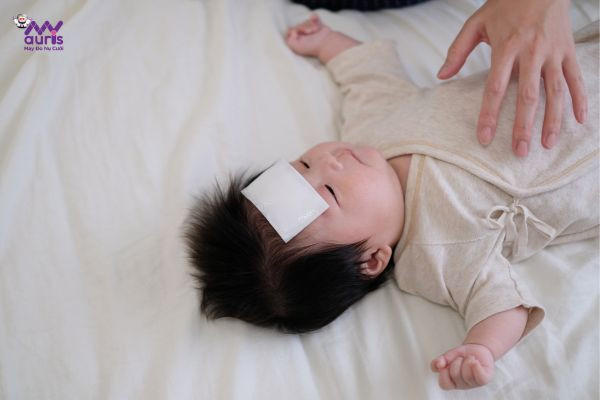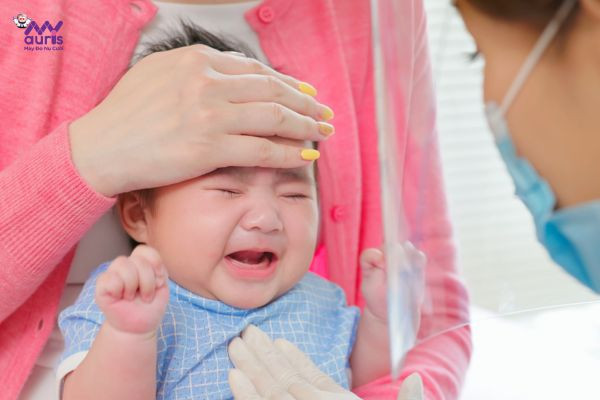Children’s immune system is still weak, so their protection ability is not high. This makes young children susceptible to minor illnesses and fevers. And during the teething process, young children also show signs of fever. At this time, mothers need to distinguish between fever due to illness or teething to have the best way to care for their children. To better understand the condition of teething babies having fever, please follow My Auris follow the following article.
Why do teething babies have fever?
For normally developing babies, the first tooth usually appears when the baby is 3-6 months old. In fact, there are cases where babies grow teeth earlier or later than the standard time. However, depending on the child’s constitution, parents should not worry too much. In case a child is 18 months old and still has no teeth, parents should take the child for a checkup.
During the teething process, babies have many symptoms, the most common being fever. According to doctors, fever due to teething is a normal reaction of the body. The main cause is that the teeth separate the gums to grow upward, causing damage to the gums, making them red, swollen and inflamed.
When the body is inflamed, the immune mechanism automatically starts and mobilizes white blood cells to fight against infections and factors harmful to the body. This action causes the body temperature to increase. Therefore, teething children are very susceptible to fever.

Distinguish between teething babies with fever and pine fever often
Children’s bodies are sensitive, their immune systems are weak, so they easily get sick and cause fever. If parents do not monitor regularly, they can confuse teething fever with normal fever. This makes mothers not know how to take good care of their children.
The common point of the two fever phenomena is that the baby’s body temperature is higher than normal, accompanied by fatigue, fussiness, poor appetite, and refusal to breastfeed. However, if you monitor the symptoms, there is a difference between teething fever and normal fever:
Teething fever
When babies start teething, they have very typical symptoms such as drooling a lot, the gums are swollen and red, and the baby may feel pain and discomfort. At this time, the baby always appears irritable and cries.
In addition,teething babies often have the habit of biting and gnawing on objects because their gums are itchy and uncomfortable. At the same time, during teething, parents may also notice that their children are tired, lethargic and sleep for many hoursThank you normally. In particular, fever due to teething is not too high, just a mild fever.
Regular fever
When normal fever, the baby’s body temperature is usually 38 degrees or higher, accompanied by symptoms of illness such as runny nose, cough, night sweats, vomiting, etc. In these cases, the baby is extremely tired and lethargic.
Depending on the severity and type of illness, the fever is high or mild. In fact, some of the main common causes of fever in young children are viral infections, bacterial infections, immune disorders, etc. Or some children also have fever after vaccination.
Thus, parents need to distinguish the fever as well as the baby’s symptoms to have the most appropriate care and treatment.

Signs to recognize a teething baby
Teething is one of the times that marks a child’s growth and development. However, each tooth that grows is a process that affects the child’s health. Therefore, parents should recognize the signs and prepare well to care for their children during the teething period.
In addition to a mild fever, teething babies also have the following symptoms:
Children drool a lot
Young children often drool but in the standard stage If you are teething or are teething, there will be more saliva in your mouth. At the same time, the child’s ability to swallow saliva is not yet complete, so excessive drooling can soak all the clothes.
Painful and swollen gums
When the tooth pushes up, the gum will separate, become red and swollen, and cause pain. This makes the baby cry a lot, or put things in his mouth. The first baby tooth to erupt is the most painful.
Children often chew and bite
Protruding teeth make children uncomfortable, so they often chew and bite everything around them. Whatever the child holds or catches, he puts in his mouth to bite.
Stop breastfeeding, eat less
Regular tooth and gum pain makes children uncomfortable, leading to more crying. At the same time, children also do not eat well, stop eating, and stop breastfeeding.
Insomnia in children
Pain not only causes discomfort but also affects sleep, especiallyis a child’s night sleep. Children are easily startled and cry.
Normally, fever as well as teething symptoms in children usually occur about 3-5 days. When the teeth completely emerge from the gums, 5-7 days later, teething symptoms will decrease. At this time, children are healthier and can eat, drink and play as usual.

How to care for your baby when teething
To reduce pain and reduce fever and discomfort for babies, experts advise parents to do some of the following:
- Use a cold towel: Use a damp towel dipped in cold water or wrapped in ice cubes to gently wipe your baby’s mouth and gums. Low temperature helps reduce swelling and pain effectively.
- Reduce fever for babies: When they have a fever, mothers can give their children age-appropriate fever-reducing medicine, in the correct dosage as instructed by the pharmacist. In addition, mothers can wipe their baby’s body with warm water and wear cool, sweat-absorbent, comfortable clothes.
- Let children drink plenty of water: Mothers should constantly give their children warm water to prevent dehydration. If the baby does not drink a bottle, mothers use a spoon to feed the baby.
- Regularly wipe away drool flowing around the child’s mouth with a soft towel. This helps clean and prevent rashes and rashes around the chin and neck. If your baby is bleeding a lot, mothers should consider wearing a bib and applying anti-diaper cream.
- Clean children’s teeth thoroughly: After each time drinking milk or eating powder, mothers should use a soft cloth to wipe their children’s gums and tongue. Mothers should pay attention to wiping gently and about 30 minutes – 1 hour before meals to avoid causing children to vomit the previous meal.
- Let your baby suck on a pacifier: If your baby has gum pain, discomfort, or crying, mothers can choose a suitable pacifier for them to suck on.
- Proper nutrition: Even if the baby has anorexia or stops eating, mothers should still build a reasonable diet, divided into many small meals a day to ensure adequate nutrition for the baby’s body.

In addition, if your child has a continuously high fever, there are symptoms such as convulsions or diarrhea, vomiting, rash, lethargy, lethargy, etc. quickly take the child to the hospital to be examined by a doctor, find the cause and fix it as soon as possible.
Above is the information aboutteething babies with fever, hopefully parents will have more useful experience in this. Take care of your child. If you are still worried, take your child to a reputable hospital or dental facility for examination immediately.
Anh Thy





